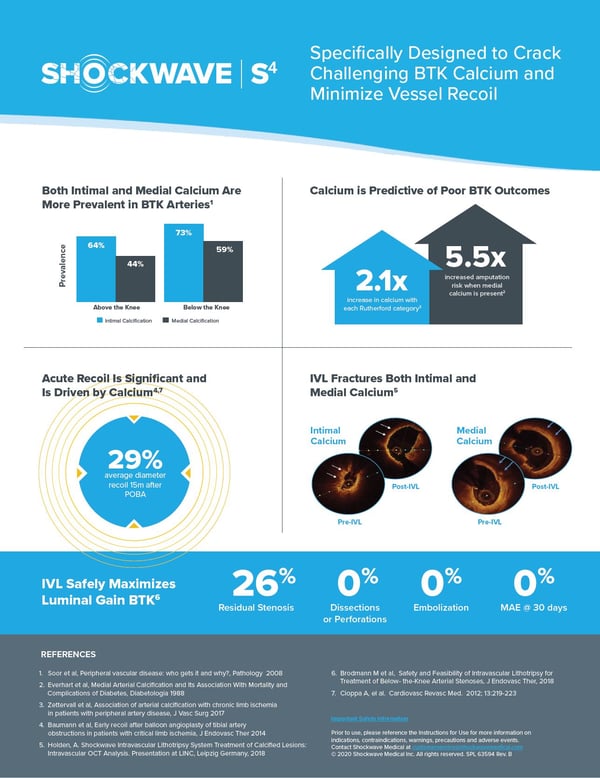BTK Recoil and Calcium: New Infographic & Video with Dr. George Adams
Acute recoil is a phenomenon in small arteries, such as those below-the-knee (BTK), when there is a significant reduction in luminal gain within just a few minutes after balloon angioplasty. Since the goal of BTK angioplasty is to maximize distal flow in order to heal wounds, recoil is a significant problem. As a result, reducing the incidence of acute recoil should be an important goal in improving BTK treatment.
While further investigation is required to fully understand the mechanisms of recoil, the relationship between recoil and poor outcomes has been established, and the relationship between intimal and medial calcium with poor CLI outcomes has been consistently demonstrated.
Some of the key data points on the relationship between calcium and CLI outcomes, the importance of BTK recoil, and the potential impact of Shockwave IVL on calcium are summarized in the below infographic.

![]()
Download the Infographic PDF Here
At VEITH 2019, Dr. George Adams from UNC Rex in Raleigh, NC spoke about the potential for Shockwave IVL to safely impact both intimal and medial calcium, potentially reducing recoil and dissection rates BTK.
Ready to get cracking with IVL? Contact Us for more information.
For the latest news on Shockwave IVL, register for updates, and for the latest cases and discussion, follow @ShockwaveIVL on Twitter!
Important Safety Information
Caution: Federal law (USA) restricts this device to sale by or on the order of a physician.
Indication for Use – The Shockwave Medical Intravascular Lithotripsy (IVL) System is intended for lithotripsy-enhanced balloon dilatation of lesions, including calcified lesions, in the peripheral vasculature, including the iliac, femoral, ilio-femoral, popliteal, infra-popliteal, and renal arteries. Not for use in the coronary or cerebral vasculature.
Contraindications – Do not use if unable to pass 0.014 guidewire across the lesion • Not intended for treatment of in-stent restenosis or in coronary, carotid, or cerebrovascular arteries.
Warnings – Only to be used by physicians who are familiar with interventional vascular procedures • Physicians must be trained prior to use of the device • Use the Generator in accordance with recommended settings as stated in the Operator’s Manual
Precautions – Use only the recommended balloon inflation medium • Appropriate anticoagulant therapy should be administered by the physician • Decision regarding use of distal protection should be made based on physician assessment of treatment lesion morphology
Adverse Effects – Possible adverse effects consistent with standard angioplasty include: • Access site complications • Allergy to contrast or blood thinners • Arterial bypass surgery • Bleeding complications • Death • Fracture of guidewire or device • Hypertension/Hypotension • Infection/sepsis • Placement of a stent • Renal failure • Shock/pulmonary edema • Target vessel stenosis or occlusion • Vascular complications. Risks unique to the device and its use: • Allergy to catheter material(s) • Device malfunction or failure • Excess heat at target site
Prior to use, please reference the Instructions for Use for more information on indications, contraindications, warnings, precautions, and adverse events. www.shockwavemedical.com



